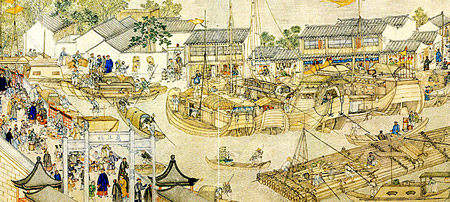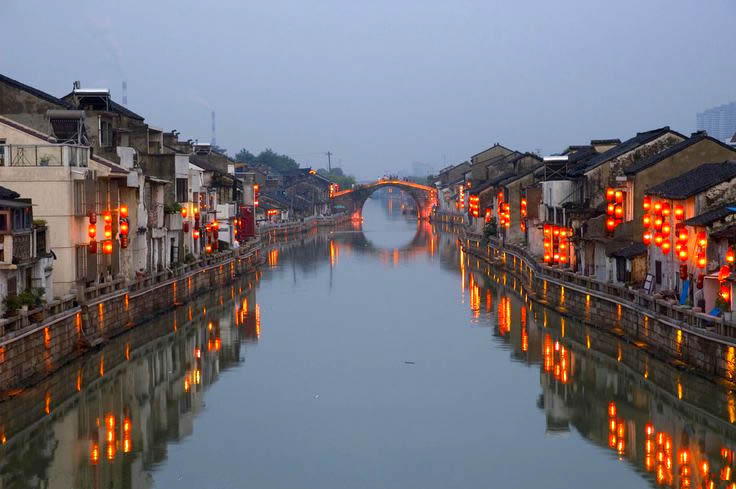 |
| Grand Canal |
Next to the Great Wall of China the Grand Canal was the most important engineering feat in ancient China and was undertaken during the Sui dynasty (581–618). Earlier, during the Qin (Ch’in) dynasty and Han dynasty major canals had been built for land reclamation and irrigation and short canals for transportation.
Sui Wendi (Sui Wen-ti), unifier of China after three centuries of division, began the Grand Canal. He rebuilt and extended the old canals to link up the Yellow River with his capital Chang’an (Ch’ang-an) on the Wei River, then southward to the Yangzi (Yangtze) River at Yangzhou (Yangchow) in central China.
His son Yangdi (Yang-ti) expanded the system to Hangzhou (Hangchow) on the coast south of the Yangzi, and northward to near modern Beijing, totaling 1,250 miles. The Grand Canal, completed in 605, symbolized the reunification of the empire, economic growth, and integration. Over the centuries the growing wealth of the south became crucial to the defense of the nation’s vulnerable northern frontier.
  |
China was politically divided during the Song (Sung) dynasty. With the loss of all northern China at the end of the Northern Song in 1127, the Grand Canal fell to disuse. In 1264 Kubilai Khan, grandson of Genghis Khan, proclaimed himself grand khan and ruler of a new Yuan dynasty in China, with the capital city at modern Beijing, which he named Dadu (T’a-tu, meaning Great Capital).
Kubilai needed grain from the Yangzi valley for his capital and had two choices for routes, by sea, where ships were subject to loss in storms, or via a safer inland waterway, the Grand Canal. He chose the canal route, which entailed repairing the old canal including a 135 mile-long section near Dadu.
Three million laborers were drafted for the task, which was completed in 1289. Maintenance was expensive and the canal again fell to disuse as the Yuan dynasty declined. The silted up sections were repaired in the early 15th century under the Ming dynasty.
 |
| Somewhere in the Grand Canal China |
The Grand Canal fulfilled several functions. It brought grains, cloth, tea, wine, and other products of the increasingly developed southeast to the politically dominant north. In integrating the country economically, it also played a vital role in the political unification of China. The Grand Canal was built and maintained at a huge cost.
Sui Yangdi conscripted over a million people for this project during his reign and labor became so short that women were also conscripted. However the million plus number was the grand total of all laborers, not the number at work at any time, because each laborer had to work for the government for only 20 days per year.
 |
| Life along side of grand canal |
Nevertheless the huge labor demands for Yangdi’s many projects caused widespread discontent that brought down his empire. Silting, currents, and the need to pull canal boats in areas of steep elevation posed difficult problems for supplying Chang’an’s 2 million people during the height of the Tang (T’ang) dynasty.
The fact that boats were fully laden on the journey north but returned south mostly empty posed economic problems that were never solved. The difficulty of supplying Chang’an was a major factor in abandoning it as the capital of China after the 10th century in favor of Luoyang (Loyang), Kaifeng (K’ai-feng), and Beijing.
 |
| Grand canal nowdays |